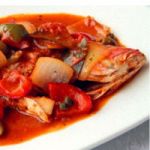 |
A culinary journey in Mexico
A look into the cooking of Mexico will lead you on a journey back to the Pre-Columbian era, through the Spanish conquest and colonization, into the kitchens of Maximilian of Hapsburg and across the country of today, peeking into bowls and sniffing the contents of terra cotta containers. Though Mexican cuisine has become diversified, it is still firmly rooted in history.
We have to go back to 700 B.C… The Meso-American civilization, or "corn" civilization, was already well-established. The staple food of all the Indian tribes, corn, was the line between man and the gods, both a common bond and a source of quarrels among the tribes. Though the young ears could simply be boiled and the juicy kernels bitten off, Indian women learned other ways of using and cooking the corn. They served it as a kind of porridge, "atole," for breakfast. When simmered with meat, it became "pozole," and the women transported it in gourds to the fields to feed the workers. Ground into flour, it was made into tortillas, the flat rounds that were either soft or crunchy, or into tamales, stuffed with beans or vegetables. Corn was also part of feasts: the flour, dissolved in water, was set aside to ferment in order to make a strong beverage flavoured with chilies or chocolate.
During the Pre-Spanish period, while Montezuma's table was groaning under the weight of the variety of meat, game and fowl that abounded in the seemingly limitless land between the two oceans, the daily diet of most people was frugal, consisting of three tortillas, chilies, highly seasoned dried beans or squash and a glass of atole, tortilla paste dissolved in milk, sweetened and flavoured with fruit or vanilla. But for special occasions, generally religious holidays, corn experienced a transformation. Such was the case during the month of Hueytozoztli, the great vigil. During April-May, tortillas were made in the shape of Chicomecatl, the goddess of subsistence, stuffed with dried beans and served with water flavoured with chia, the seed of a variety of sage.
Then in May-June came the month of the god Etzcualiztli. Corn was cooked with dried beans, a heavy food to signify abundance, whether of food or of rain. June-July saw the feast of the lords Huey Tecuhuitl and ceremonies dedicated to the goddess of the young ears of corn. Tamales were stuffed with meat or game, accompanied by water mixed with pinole (roasted corn flour); only the priests had the right to drink pulque, a fermented beverage made from agave, and an antecedent of tequila.
July-August paid homage to the sun god Huitzilopochhtli. The tamales became huge and might contain an entire turkey… or a fattened dog! They were decorated with flowers and feathers and adorned with pastry mixed with mushrooms to represent the warriors and other victims sacrificed to the sun god. The tamales were cut up and offered to the priests, accompanied by mountains of quails.
Then came the Spanish conquest. During colonization, barley, rice, wheat, olives, wine, cattle and sheep appeared. Each culture influenced the other. Indian women working in Spanish kitchens continued to roll out tortillas, and to roast fresh peppers and corn to make pinole. Spanish beef was paired with native Indian sauces - Mexican cooking began to find its authentic flavours. Convents sprang up everywhere. In 1700, there were 22 in Mexico City alone. Others were found in the towns of Puebla, Michoacàn and Oaxaca. The sisters made gastronomic strides with the local cuisine and turned the fruit into wonderful desserts.

Flavors of the state of Veracruz
Photo : Avocado Central (Hass)

-

 Recipes
Recipes
-

 Products
Products
-

 Entertaining
Entertaining
-

 Chefs
Chefs
-

 Hints & Tips
Hints & Tips
-

 Glossaries
Glossaries








